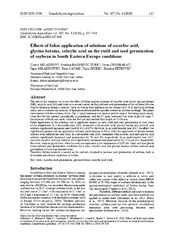Приказ основних података о документу
Effects of foliar application of solutions of ascorbic acid, glycine betaine, salicylic acid on the yield and seed germination of soybean in South Eastern Europe conditions
| dc.creator | Miladinov, Zlatica | |
| dc.creator | Balešević-Tubić, Svetlana | |
| dc.creator | Crnobarac, Jovan | |
| dc.creator | Miladinović, Jegor | |
| dc.creator | Čanak, Petar | |
| dc.creator | Đukić, Vojin | |
| dc.creator | Petrović, Kristina | |
| dc.date.accessioned | 2021-04-26T19:55:22Z | |
| dc.date.available | 2021-04-26T19:55:22Z | |
| dc.date.issued | 2020 | |
| dc.identifier.issn | 1392-3196 | |
| dc.identifier.uri | http://fiver.ifvcns.rs/handle/123456789/2037 | |
| dc.description.abstract | The aim of the research was to test the effect of foliar-applied solutions of ascorbic acid (AsA), glycine betaine (GB), salicylic acid (SA) and water as a second control on the yield and seed germination of the soybean (Glycine hispida (Moench) Maxim.) cultivar 'Sava' as well as their influence on the content of N, P, K and Ca in soybean seeds, and to estimate the intensity of lipid peroxidation and free proline content in soybean seedlings. The plants were treated with the solutions twice. The 1st spray treatment was done at growth stage 6: flowering (main shoot), when first flowers opened (sporadically in population), and the 2nd spray treatment was done at growth stage 7: development of fruits and seeds, when the first pod had reached final length of 15-20 mm. Foliar application of the solutions had a significant impact on seed yield and seed germination in both years of the experiment. In a favourable year 2016, treatments with ascorbic acid, glycine betaine and salicylic acid solution significantly increased seed yield by 6.21-9.67%. However, in an unfavourable year 2017, the effect was significantly greater with the application of water (yield increase 6.48%), while the application of glycine betaine solution even reduced the seed yield. In a favourable year 2016, treatments with ascorbic acid and salicylic acid solution significantly increased seed germination by 7% and 8%, respectively. In an unfavourable year 2017, also only ascorbic acid and salicylic acid significantly increased seed germination by 11% and 9%, respectively. However, when using cold test, when the seed was exposed to a low temperature of 10 degrees C for 7 days and then placed under optimal seed germination conditions for 4 days, ascorbic acid and glycine betaine solution reduced seed germination in both experimental years. Therefore, further research is needed on the methods designed to increase seed germination of soybean, both in favourable and adverse conditions in Serbia. | en |
| dc.publisher | Lithuanian Research Centre Agriculture & Forestry, Kedainiu R | |
| dc.relation | info:eu-repo/grantAgreement/MESTD/inst-2020/200032/RS// | |
| dc.rights | openAccess | |
| dc.rights.uri | https://creativecommons.org/licenses/by-nc-nd/4.0/ | |
| dc.source | Zemdirbyste-Agriculture | |
| dc.subject | ascorbic acid | en |
| dc.subject | germination | en |
| dc.subject | glycine betaine | en |
| dc.subject | salicylic acid | en |
| dc.subject | yield | en |
| dc.title | Effects of foliar application of solutions of ascorbic acid, glycine betaine, salicylic acid on the yield and seed germination of soybean in South Eastern Europe conditions | en |
| dc.type | article | |
| dc.rights.license | BY-NC-ND | |
| dc.citation.epage | 344 | |
| dc.citation.issue | 4 | |
| dc.citation.other | 107(4): 337-344 | |
| dc.citation.rank | M22 | |
| dc.citation.spage | 337 | |
| dc.citation.volume | 107 | |
| dc.identifier.doi | 10.13080/z-a.2020.107.043 | |
| dc.identifier.fulltext | http://fiver.ifvcns.rs/bitstream/id/966/2034.pdf | |
| dc.identifier.scopus | 2-s2.0-85092401630 | |
| dc.identifier.wos | 000580818600007 | |
| dc.type.version | publishedVersion |


